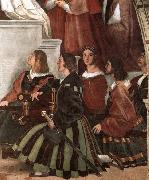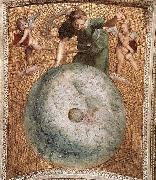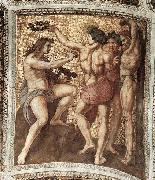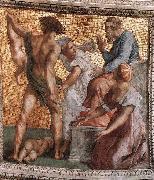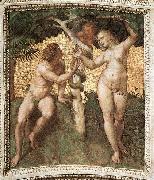
|
Artists
Index
|
||
|
RAFFAELLO Sanzio
|
||
|
The Mass at Bolsena new21/RAFFAELLO Sanzio-862279.jpg Pintura identificación:: 63800 |
1512 Fresco Stanza di Eliodoro, Palazzi Pontifici, Vatican Julius II had founded the Swiss Guard as a military elite in May 1510, and granted them the distinction of their own costume. The Guard had played a vital role in a victory over French forces, who had occupied parts of the Papal State. The pope was probably bestowing an honour on them for that loyal service by letting Raphael portray some of their important representatives in the fresco, thus giving them pride of place in his audience chamber.Artist:RAFFAELLO Sanzio Title: The Mass at Bolsena (detail) Painted in 1501-1550 , Italian - - painting : religious | |
| |
|
|
|
|
||
|
Prime Mover new21/RAFFAELLO Sanzio-954527.jpg Pintura identificación:: 63801 |
1509-11 Fresco, 120 x 105 cm Stanza della Segnatura, Palazzi Pontifici, Vatican The figure bending in a beautiful scorcio over the celestial globe is a masterly example of perspective. Philosophically, this figure can be seen as an allegory of the beginning of the universe, but it might also be an embodiment of the science of astronomy. The constellation on the globe can be calculated exactly: the night of 31 October 1503, the date that Julius II was elected pope.Artist:RAFFAELLO Sanzio Title: Prime Mover (ceiling panel) Painted in 1501-1550 , Italian - - painting : religious | |
| |
|
|
|
|
||
|
Apollo and Marsyas new21/RAFFAELLO Sanzio-374467.jpg Pintura identificación:: 63802 |
1509-11 Fresco, 120 x 105 cm Stanza della Segnatura, Palazzi Pontifici, Vatican The shepherd Marsyas had challenged the god Apollo to a musical contest. Marsyas lost and as a punishment for daring to challenge a god he was flayed alive. The scene is an allegory of divine harmony triumphing over earthly passion. With its unrhythmical composition and its elongated figures, this scene is probably by an unknown hand, and not by Raphael.Artist:RAFFAELLO Sanzio Title: Apollo and Marsyas (ceiling panel) Painted in 1501-1550 , Italian - - painting : mythological | |
| |
|
|
|
|
||
|
The Judgment of Solomon new21/RAFFAELLO Sanzio-426954.jpg Pintura identificación:: 63803 |
1510-11 Fresco, 120 x 105 cm Stanza della Segnatura, Palazzi Pontifici, Vatican The story from the Old Testament tells how two women came to Solomon to settle a dispute about which one was the mother of a child. When Solomon ordered the baby to be cut in half, one of the women agreed to give up the child. Solomon recognized her as the true mother. The man holding the sword derives from a classical figure, either Castor or Pollux from the Quirinal, an ancient Roman palace.Artist:RAFFAELLO Sanzio Title: The Judgment of Solomon (ceiling panel) Painted in 1501-1550 , Italian - - painting : religious | |
| |
|
|
|
|
||
|
Adam and Eve new21/RAFFAELLO Sanzio-674334.jpg Pintura identificación:: 63804 |
1509-11 Fresco, 120 x 105 cm Stanza della Segnatura, Palazzi Pontifici, Vatican This portrayal of the Fall is generally attributed to Raphael. Standing in a distinct contrapposto pose, Eve recalls the figure of Leda in a study by Leonardo da Vinci - Raphael made a drawing of this while he was in Florence.Artist:RAFFAELLO Sanzio Title: Adam and Eve (ceiling panel) Painted in 1501-1550 , Italian - - painting : religious | |
| |
|
|
|
|
||
| Previo Artista Próximo Artista | ||
|
Also Buy::. For Following Paintings / Artists / Products, Please Use Our Search Online: |





